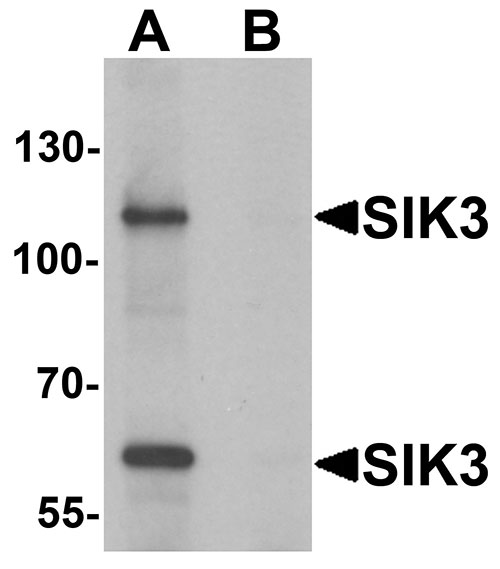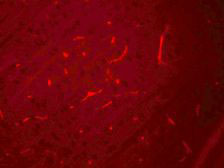SIK3 Antibody
- 产品详情
- 实验流程
- 背景知识
Application
| WB, IF, E |
|---|---|
| Primary Accession | Q9Y2K2 |
| Other Accession | NP_079440, 38569491 |
| Reactivity | Human, Mouse, Rat |
| Host | Chicken |
| Clonality | Polyclonal |
| Isotype | IgY |
| Calculated MW | 144851 Da |
| Concentration (mg/ml) | 1 mg/mL |
| Conjugate | Unconjugated |
| Application Notes | SIK3 antibody can be used for detection of SIK3 by Western blot at 1 µg/mL. Antibody can also be used for immunofluorescence starting at 20 µg/mL. For immunofluorescence start at 20 µg/mL. |
| Gene ID | 23387 |
|---|---|
| Other Names | Serine/threonine-protein kinase SIK3, 2.7.11.1, Salt-inducible kinase 3, SIK-3, Serine/threonine-protein kinase QSK, SIK3, KIAA0999, QSK |
| Target/Specificity | SIK3; At least three isoforms of SIK3 are known to exist; this antibody will detect two isoforms. SIK3 antibody is predicted to not cross-react with SIK1 and SIK2. |
| Reconstitution & Storage | SIK3 antibody can be stored at 4℃ for three months and -20℃, stable for up to one year. As with all antibodies care should be taken to avoid repeated freeze thaw cycles. Antibodies should not be exposed to prolonged high temperatures. |
| Precautions | SIK3 Antibody is for research use only and not for use in diagnostic or therapeutic procedures. |
| Name | SIK3 (HGNC:29165) |
|---|---|
| Function | Positive regulator of mTOR signaling that functions by triggering the degradation of DEPTOR, an mTOR inhibitor. Involved in the dynamic regulation of mTOR signaling in chondrocyte differentiation during skeletogenesis (PubMed:30232230). Negatively regulates cAMP signaling pathway possibly by acting on CRTC2/TORC2 and CRTC3/TORC3 (Probable). Prevents HDAC4 translocation to the nucleus (By similarity). |
| Cellular Location | Cytoplasm. Note=Locates to punctate structures within the cytoplasm on binding to YWHAZ. |
| Tissue Location | Expressed in chondrocytes. |
For Research Use Only. Not For Use In Diagnostic Procedures.
Provided below are standard protocols that you may find useful for product applications.
BACKGROUND
SIK3 Antibody: Salt-inducible kinase family (SIKs) proteins are thought to have a role in steroidogenesis, adipogenesis or regulation of tumor malignancy. Three members (SIK1, SIK2 and SIK3) in the SIK family have been identified thus far. Their kinase domain sequences are closely homologous to those of AMP-activated protein kinase (AMPK). SIK3 can be phosphorylated by a tumor-suppressor kinase LKB1. It is highly and preferentially expressed in ovarian tumors but not in adenomyosis and leiomyoma and may be a potential diagnostic marker for ovarian cancers.
REFERENCES
Katoh Y, Takemori H, Horike N, et al. Salt-inducible kinase (SIK) isoforms: their involvement in steroidogenesis and adipogenesis. Mol. Cell. Endocrinol. 2004; 217:109-12.
Al-Hakim AK, Göransson O, Deak M, et al. 14-3-3 cooperates with LKB1 to regulate the activity and localization of QSK and SIK. J. Cell Sci. 2005; 118:5661-73.
Charoenfuprasert S, Yang YY, Lee YC, et al. Identification of salt-inducible kinase 3 as a novel tumor antigen associated with tumorigenesis of ovarian cancer. Oncogene 2011; 30:3570-84.
终于等到您。ABCEPTA(百远生物)抗体产品。
点击下方“我要评价 ”按钮提交您的反馈信息,您的反馈和评价是我们最宝贵的财富之一,
我们将在1-3个工作日内处理您的反馈信息。
如有疑问,联系:0512-88856768 tech-china@abcepta.com.























 癌症的基本特征包括细胞增殖、血管生成、迁移、凋亡逃避机制和细胞永生等。找到癌症发生过程中这些通路的关键标记物和对应的抗体用于检测至关重要。
癌症的基本特征包括细胞增殖、血管生成、迁移、凋亡逃避机制和细胞永生等。找到癌症发生过程中这些通路的关键标记物和对应的抗体用于检测至关重要。 为您推荐一个泛素化位点预测神器——泛素化分析工具,可以为您的蛋白的泛素化位点作出预测和评分。
为您推荐一个泛素化位点预测神器——泛素化分析工具,可以为您的蛋白的泛素化位点作出预测和评分。 细胞自噬受体图形绘图工具为你的蛋白的细胞受体结合位点作出预测和评分,识别结合到自噬通路中的蛋白是非常重要的,便于让我们理解自噬在正常生理、病理过程中的作用,如发育、细胞分化、神经退化性疾病、压力条件下、感染和癌症。
细胞自噬受体图形绘图工具为你的蛋白的细胞受体结合位点作出预测和评分,识别结合到自噬通路中的蛋白是非常重要的,便于让我们理解自噬在正常生理、病理过程中的作用,如发育、细胞分化、神经退化性疾病、压力条件下、感染和癌症。







